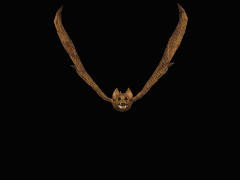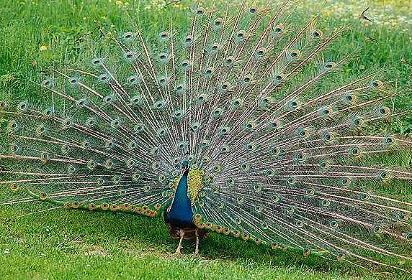


|
Galliformes:
The Galliformes is an order of birds containing the turkeys, grouse, quails, and pheasants. About 256 species are found worldwide. These birds vary in size from the diminutive Asian Rain Quails (Excalfactoria chinensis) at 12.5 cm long and weighing 28 to 40 g to the largest extant Galliform species, is the North American Wild Turkey (Meleagris gallopavo), wild specimens of which may weigh as much as 14 kilograms (about 30 pounds) and may exceed 120 cm. The Galliform bird species with the largest wing-span is most likely the Green Peafowl (Pavo muticus). Most Galliform genera are large in body with thick necks and moderately long legs and with rounded wings. Grouse, pheasants, francolins, and partridges are typical in their outwardly corpulent silhouettes. Some Galliformes are adapted to grassland habitats and these genera are remarkable for their long, thin necks, long legs and large, wide wings. Thus Wild Turkeys, Crested Fireback Pheasants, typical peafowl and Vulturine Guineafowl are outwardly similar in their convergent body types. Vegetarian and slightly omnivorous genera are typically stoutly built and have short thick bills primarily adapted for foraging on the ground for rootlets or the consumption of other plant material such as heather shoots. The young birds will also take insects. Peafowls, junglefowl and most of the sub-tropical pheasant genera have very different nutritional requirements from typical Palearctic genera. Metatarsal spurs and bills reinforced at the cere are physical adaptations enabling the sub-tropical gallinates to rake through leaf debris and dig in rotting wood for the live foods required for their survival. The Himalayan Monal (Lophophorus impejanus) has been observed digging in the rotting wood of deadfall in a similar manner as woodpeckers, even bracing itself with aid of its squared tail. The Himalayan Griffin or Chir Pheasant (Catreus wallichi), Crested Argus or Ocellated Argus (Rheinardia ocellata), The enigmatic Roul roul or Crested Wood Partridge (Roullus roullus) and the Crested Guineafowl (Guttera pucherani) are similar ecologically to the Himalayan Monal in that they too forage in rotting wood for termites, ant and beetle larvae, molluscs, crustaceans and the nests of rodents. Typical peafowl (Pavo), the so-called peacock-pheasants (Polyplectron), with the exception of the Mountain Peacock-Pheasant (Polyplectron inopinatum, the Bornean Wattled Pheasant (Lobiophasis bulweri), the ruffed pheasants (Chrysolophus) and the Hill Partridges (Arborphila) have narrow, relatively delicate bills, poorly suited for digging. These Galliform genera prefer instead to capture live insects in leaf litter, in sand and in shallow pools or along stream banks. These genera are also outwardly similar in that they each have exceptionally long, delicate legs and toes and the tendency to frequent seasonally, semi aquatic habitats to forage, especially during chick rearing.
The Shan Pheasant (Chrysolophus amherstiae), Green Peafowl(Pavo muticus superspecies complex), Bornean Wattled Pheasant and the Crestless Buffalo Pheasant or Crestless Fireback (Acomus erythropthalma)are notable for their aptitude to forage for crustaceans such as crayfish and other aquatic small animals in shallow streams and amongst rushes in much the same manner as members of the rail family.
The Himalayan Starhawks or Tragopans (Tragopan), Mikado Pheasant, and several species of grouse and ptarmigan are exceptional in their largely vegetarian and arboreal foraging habitats. But many species of moderate altitudes for example the Long Tailed or Pine Dagger pheasants of the genus Syrmaticus find a great deal of their daily nutrtional reqirements in the tree canopies especially during the snowy and rainy periods when foraging on the ground is dangerous and less than fruitful for a variety of reasons. The Great Argus and Crested Argus may do most of their foraging during rainy months in the canopy of the jungle as well.
Whereas members of the Syrmaticus are capable of subsisting almost entirely on vegetarian materials for months at a time this is not true for many of the subtropical genera. For example, the two Argus genera are known to forage on slugs, snails, ants and amphibians to the exclusion of plant material. How they forage in the forest canopy during the rainy months is unknown but a compelling issue for future investigations.
Most of these birds are more or less resident, but some of the smaller temperate species, such as quail, do migrate over considerable distances. Altitudinal migration is evidentally quite common amongst montane species and a few species of subtropical and near arctic regions must reach their watering and/or foraging areas through sustained flight. Species known to make extensive flights include the Ptarmigans, Sage Grouse, Roul Roul, Green Peafowls, Crested Argus, Mountain Peacock Pheasant, Koklass, Arrow or Reeve's pheasant and Green Junglefowl. Other species for example, most of the Toothed Quails also known as New World Quails, the enigmatic African Stone Partridge or Rock Bantam, Guineafowls and Eared. Pheasants are all notable for their daily excursions on foot which may take them many miles in a given day. Most species that show only limited sexual dimochatisims and size differences are notable for the great amount of locomotion required to find food throughout the majority of the year. Those species that are highly sedentary but with marked ecological transformations over seasons exhibit marked distinct differences between the sexes in size or appearance. Eared Pheasants, guineafowls, snow partridges and toothed quails are examples of limited sexual differences and requirements for traveling over wide terrain to forage. The Sumatran Bronze Tailed Polyplectron, Snow Partridge, Painted Spurfowl(Galloperdix) and Crimson-headed Wood Partridge (Haematortyx) are notable in their habit of not only moving by foot but also in the air as pairs in the manner of doves.
|
